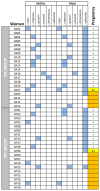Immunomodulation of the Vaginal Ecosystem by Ligilactobacillus salivarius CECT 30632 Improves Pregnancy Rates among Women with Infertility of Unknown Origin or Habitual Abortions
- PMID: 36678233
- PMCID: PMC9860997
- DOI: 10.3390/nu15020362
Immunomodulation of the Vaginal Ecosystem by Ligilactobacillus salivarius CECT 30632 Improves Pregnancy Rates among Women with Infertility of Unknown Origin or Habitual Abortions
Abstract
In this study, the probiotic potential of Ligilactobacillus salivarius CECT 30632 was assessed, including properties specifically related with gynecological targets. This strain displayed co-aggregative and antimicrobial activity against a wide spectrum of vaginal pathogens while being respectful with the growth of vaginal lactobacilli. The strain produced a high concentration of lactic acid and displayed α-amylase activity when assayed in vitro. It showed a noticeable survival rate after exposition to conditions similar to those present in the human digestive tract and was adhesive to both vaginal and intestinal cells. Subsequently, their capacity to increase pregnancy rates among women with habitual abortion or infertility of unknown origin was studied. Administration of L. salivarius CECT 30632 (~9 log10 CFU) daily for a maximum of six months to these women was safe and led to a successful pregnancy rate of 67.5% (80% and 55% for women with repetitive abortion and infertile women, respectively). Significant differences in Nugent score, vaginal pH, and vaginal concentrations of lactobacilli, TGF-β, and VEFG were observed when the samples collected before the intervention were compared with those collected after the treatment among those women who got pregnant. Therefore, this strain can modulate the vaginal ecosystem and lead to better fertility outcomes.
Keywords: Ligilactobacillus salivarius; TGF-β; VEGF; habitual abortion; infertility; probiotics; safety.
Conflict of interest statement
The authors declare that the research was conducted in the absence of any commercial or financial relationships that could be construed as a potential conflict of interest.
Figures


Similar articles
-
Application of Ligilactobacillus salivarius CECT5713 to Achieve Term Pregnancies in Women with Repetitive Abortion or Infertility of Unknown Origin by Microbiological and Immunological Modulation of the Vaginal Ecosystem.Nutrients. 2021 Jan 6;13(1):162. doi: 10.3390/nu13010162. Nutrients. 2021. PMID: 33419054 Free PMC article.
-
Rectal and Vaginal Eradication of Streptococcus agalactiae (GBS) in Pregnant Women by Using Lactobacillus salivarius CECT 9145, A Target-specific Probiotic Strain.Nutrients. 2019 Apr 10;11(4):810. doi: 10.3390/nu11040810. Nutrients. 2019. PMID: 30974819 Free PMC article. Clinical Trial.
-
Ligilactobacillus salivarius PS11610 exerts an effect on the microbial and immunological profile of couples suffering unknown infertility.Am J Reprod Immunol. 2022 Jul;88(1):e13552. doi: 10.1111/aji.13552. Epub 2022 May 11. Am J Reprod Immunol. 2022. PMID: 35506742
-
Ligilactobacillus salivarius functionalities, applications, and manufacturing challenges.Appl Microbiol Biotechnol. 2022 Jan;106(1):57-80. doi: 10.1007/s00253-021-11694-0. Epub 2021 Dec 10. Appl Microbiol Biotechnol. 2022. PMID: 34889985 Review.
-
Understanding Ligilactobacillus salivarius from Probiotic Properties to Omics Technology: A Review.Foods. 2024 Mar 15;13(6):895. doi: 10.3390/foods13060895. Foods. 2024. PMID: 38540885 Free PMC article. Review.
Cited by
-
Streptococcus salivarius and Ligilactobacillus salivarius: Paragons of Probiotic Potential and Reservoirs of Novel Antimicrobials.Microorganisms. 2025 Feb 28;13(3):555. doi: 10.3390/microorganisms13030555. Microorganisms. 2025. PMID: 40142448 Free PMC article. Review.
-
Ligilactobacillus salivarius CECT5713 Increases Term Pregnancies in Women with Infertility of Unknown Origin: A Randomized, Triple-Blind, Placebo-Controlled Trial.Nutrients. 2025 May 29;17(11):1860. doi: 10.3390/nu17111860. Nutrients. 2025. PMID: 40507130 Free PMC article. Clinical Trial.
-
The Safety of Probiotics Intended for Use in Pregnant and Lactating Women: From a Desirable to a Required Task.Foods. 2024 Dec 12;13(24):4024. doi: 10.3390/foods13244024. Foods. 2024. PMID: 39766967 Free PMC article. Review.
-
The Relationship Between Gut Microbiota and Recurrent Spontaneous Abortion.Microorganisms. 2025 May 4;13(5):1073. doi: 10.3390/microorganisms13051073. Microorganisms. 2025. PMID: 40431246 Free PMC article. Review.
-
Pilot Study on Next-Generation Sequencing Analysis of Vaginal Microbiota in Clinically Infertile Patients Treated with Probiotics.J Clin Med. 2024 Jun 11;13(12):3420. doi: 10.3390/jcm13123420. J Clin Med. 2024. PMID: 38929949 Free PMC article.
References
-
- Cascardi E., Cazzato G., Daniele A., Silvestris E., Cormio G., Di Vagno G., Malvasi A., Loizzi V., Scacco S., Pinto V., et al. Association between cervical microbiota and HPV: Could this be the key to complete cervical cancer eradication? Biology. 2022;11:1114. doi: 10.3390/biology11081114. - DOI - PMC - PubMed
-
- Al-Memar M., Bobdiwala S., Fourie H., Mannino R., Lee Y.S., Smith A., Marchesi J.R., Timmerman D., Bourne T., Bennett P.R., et al. The association between vaginal bacterial composition and miscarriage: A nested case-control study. BJOG. 2020;127:264–274. doi: 10.1111/1471-0528.15972. - DOI - PMC - PubMed
MeSH terms
Grants and funding
LinkOut - more resources
Full Text Sources
Medical

